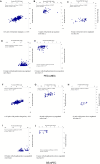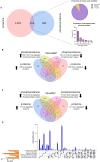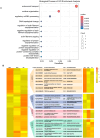Proteomic and Phosphoproteomic Analyses during Plant Regeneration Initiation in Cotton (Gossypium hirsutum L.)
- PMID: 39202437
- PMCID: PMC11353933
- DOI: 10.3390/genes15081079
Proteomic and Phosphoproteomic Analyses during Plant Regeneration Initiation in Cotton (Gossypium hirsutum L.)
Abstract
Somatic embryogenesis (SE) is a biotechnological tool used to generate new individuals and is the preferred method for rapid plant regeneration. However, the molecular basis underlying somatic cell regeneration through SE is not yet fully understood, particularly regarding interactions between the proteome and post-translational modifications. Here, we performed association analysis of high-throughput proteomics and phosphoproteomics in three representative samples (non-embryogenic calli, NEC; primary embryogenic calli, PEC; globular embryos, GE) during the initiation of plant regeneration in cotton, a pioneer crop for genetic biotechnology applications. Our results showed that protein accumulation is positively regulated by phosphorylation during SE, as revealed by correlation analyses. Of the 1418 proteins that were differentially accumulated in the proteome and the 1106 phosphoproteins that were differentially regulated in the phosphoproteome, 115 proteins with 229 phosphorylation sites overlapped (co-differential). Furthermore, seven dynamic trajectory patterns of differentially accumulated proteins (DAPs) and the correlated differentially regulated phosphoproteins (DRPPs) pairs with enrichment features were observed. During the initiation of plant regeneration, functional enrichment analysis revealed that the overlapping proteins (DAPs-DRPPs) were considerably enriched in cellular nitrogen metabolism, spliceosome formation, and reproductive structure development. Moreover, 198 DRPPs (387 phosphorylation sites) were specifically regulated at the phosphorylation level and showed four patterns of stage-enriched phosphorylation susceptibility. Furthermore, enrichment annotation analysis revealed that these phosphoproteins were significantly enriched in endosomal transport and nucleus organization processes. During embryogenic differentiation, we identified five DAPs-DRPPs with significantly enriched characteristic patterns. These proteins may play essential roles in transcriptional regulation and signaling events that initiate plant regeneration through protein accumulation and/or phosphorylation modification. This study enriched the understanding of key proteins and their correlated phosphorylation patterns during plant regeneration, and also provided a reference for improving plant regeneration efficiency.
Keywords: cotton; plant regeneration; proteomic and phosphoproteomic analyses; somatic embryogenesis.
Conflict of interest statement
The authors declare no conflict of interest.
Figures




Similar articles
-
Global landscape of protein phosphorylation during plant regeneration initiation in cotton (Gossypium hirsutum L.).BMC Biol. 2025 Apr 30;23(1):116. doi: 10.1186/s12915-025-02218-7. BMC Biol. 2025. PMID: 40307803 Free PMC article.
-
Dynamic TMT-Based Quantitative Proteomics Analysis of Critical Initiation Process of Totipotency during Cotton Somatic Embryogenesis Transdifferentiation.Int J Mol Sci. 2019 Apr 4;20(7):1691. doi: 10.3390/ijms20071691. Int J Mol Sci. 2019. PMID: 30987365 Free PMC article.
-
Dynamic Transcriptome Analysis Reveals Uncharacterized Complex Regulatory Pathway Underlying Genotype-Recalcitrant Somatic Embryogenesis Transdifferentiation in Cotton.Genes (Basel). 2020 May 7;11(5):519. doi: 10.3390/genes11050519. Genes (Basel). 2020. PMID: 32392816 Free PMC article.
-
Insights from Proteomic Studies into Plant Somatic Embryogenesis.Proteomics. 2018 Mar;18(5-6):e1700265. doi: 10.1002/pmic.201700265. Epub 2018 Feb 23. Proteomics. 2018. PMID: 29369500 Review.
-
Enrichment techniques employed in phosphoproteomics.Amino Acids. 2012 Sep;43(3):1025-47. doi: 10.1007/s00726-011-1111-z. Epub 2011 Oct 15. Amino Acids. 2012. PMID: 22002794 Free PMC article. Review.
Cited by
-
Global landscape of protein phosphorylation during plant regeneration initiation in cotton (Gossypium hirsutum L.).BMC Biol. 2025 Apr 30;23(1):116. doi: 10.1186/s12915-025-02218-7. BMC Biol. 2025. PMID: 40307803 Free PMC article.
References
-
- Yao Y., Xiang D., Wu N., Wang Y., Chen Y., Yuan Y., Ye Y., Hu D., Zheng C., Yan Y., et al. Control of rice ratooning ability by a nucleoredoxin that inhibits histidine kinase dimerization to attenuate cytokinin signaling in axillary buds. Mol. Plant. 2023;16:1911–1926. doi: 10.1016/j.molp.2023.10.009. - DOI - PubMed
-
- Zhang S., Zhu C., Zhang X., Liu M., Xue X., Lai C., Xu X., Chen Y., Zhang Z., Lai Z., et al. Single-cell RNA sequencing analysis of the embryogenic callus clarifies the spatiotemporal developmental trajectories of the early somatic embryo in Dimocarpus longan. Plant J. 2023;115:1277–1297. doi: 10.1111/tpj.16319. - DOI - PubMed
MeSH terms
Substances
Grants and funding
LinkOut - more resources
Full Text Sources

